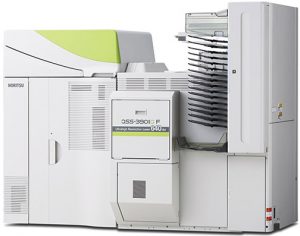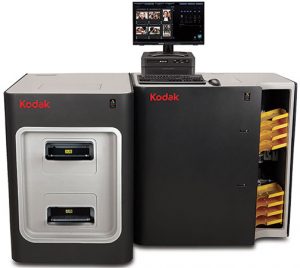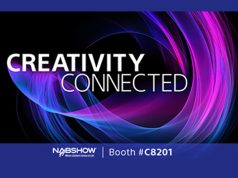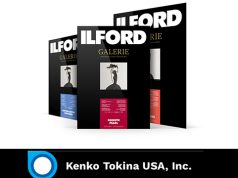
The advent of one-hour photo processing brought about major changes in consumer imaging. Turnaround times went from days or weeks to film development and better exposed, color-corrected prints in less than an hour. Decades later, wet labs turned dry; the photo industry was on its way to becoming faster, better and greener. Many of the leading contributors to the photo print evolution are still in business today. Moreover, they are continuing the minilab evolution by developing improved systems to process and deliver your customers’ prints. Here’s an overview of some of the major players.
The Minilab Evolution
Noritsu America Corporation
Noritsu Koki Co. announced its original Quick Service System (QSS-1) photofinishing platform in 1976. That was just three years before Noritsu America released the QSS-2, the digital minilab that kickstarted one-hour photo processing. The QSS-2 incorporated a microprocessor capable of controlling the photofinishing operation—from film development through color printing—in 45 minutes.
“The one-hour photo process raised customers’ print quality expectations and also created excitement in the photo industry by showing consumers their prints in less than an hour,” says Jeff Dunst, vice president, Imaging Sales, Noritsu. “This created tremendous growth—not just in photo printing but in all things photography.”

Furthermore, Noritsu introduced its first inkjet (dry) minilab system in 2002. Nortisu developed the dDP-411 digital dry printer with Seiko Epson; it employed Epson’s seven-color piezo inkjet system. The printer was significantly cheaper than a full-size wet lab and less than half the size of standard minilabs and other inkjet systems.
What’s more, Noritsu’s most recent silver halide (wet) minilabs, the QSS-3901 and 3904 high-speed photo printers, debuted in 2018.
“These are the culmination of evolutionary changes in our traditional wet printer/processor product line; they are the only products capable of running very thin book papers (135μm) and working with Kodak’s DP2 software,” says Dunst. “They also have native 640×640-dpi solid state lasers that print in 8- or 12-bit color.
“Our dry systems continually evolve, with the QSS Green IV our latest model. We have products to suit most every customer need—dry or wet, from small to large volumes. Noritsu’s front-end software, EZ Controller, sets the bar for ease of use; the ability to add custom profiles for the printer or monitor; and its AccuSmart image-processing technology. The same EZ Controller software runs all of our printers, wet and dry,” adds Dunst.
Kodak Moments
Eastman Kodak Company introduced its first American-made photofinishing minilab in July 1987. The landmark product, the Minilab System 20, was intended for a low-volume photofinishing market. This included college bookstores, food and drugstores, video stores, amusement parks as well as hotels. The system could handle 20 orders an hour; it also provided the same photofinishing quality as Kodak’s high-speed 3510 color printer, introduced in October 1986.
The first in-market test of Kodak’s popular Picture Maker digital imaging workstation—based on dye-sublimation thermal technology—was introduced in 4Q 1993. Moreover, the integrated system included a computer, monitor, print scanner, thermal printer and software. The first generation Kodak Picture Maker was released in 1996.

“Eastman Kodak, which Kodak Moments and Kodak Alaris spun off from in 2013, was among the first to initiate the dry minilab space with our thermal technologies,” says Steve Turberg, director, Current Retail Product Solutions, Kodak Moments. “The dye-sublimation print space, over time, evolved significantly, transforming retail establishments away from traditional wet products to fully dry solutions.
“We were an industry leader when we introduced the APEX (Adaptive Picture Exchange) system in the mid-2000s,” he continues. “It took about five years to penetrate and flip the retail minilab environment from wet labs to APEX.”
APEX dry lab systems are modular minilab systems; they are primarily based on thermal technology but capable of a great deal of flexibility.
“Kodak Moments continues to maintain and modernize the APEX system,” adds Turberg. “For example, recent upgrades include installing small-format, small-footprint, dye-sublimation Kodak 305 photo printers to APEX systems in a major drugstore chain.” The 305s are capable of outputting what Turberg refers to as 5R formats—3.5×5-, 5×5- and 5×7-inch prints.
Smaller Printers, More Print Diversity
“We’ve seen great quality advancements with thermal, and now inkjet, technology; however, the real benefit of the shift away from wet labs was to retailers, because of environmental concerns, reduction of labor, smaller footprints and, in many cases, the addition of unique features and products that weren’t considered in a more chemically oriented world. The products have changed significantly from ‘prints only’ to a whole new premium gifting segment—both in-store and out.
“We continue to spend a lot of time and effort growing that side of our business, because self-service is a critical function of product fulfillment,” says Turberg. “We are laser focused on the fundamentals of a kiosk system and how to modify that to meet the expanding demands of retail self-service. One option is the development of self-service print stations that allow customers to print in a high-volume fashion.”
In addition, Kodak Moments’ newest kiosk product is the midrange M1 order station. It’s a scalable photo printing kiosk that permits consumers to easily print photos from their phones, USB drives or SD cards. Introduced in 2019, the M1 order station is scalable from a small desktop station to a full standing kiosk.
“Of course,” adds Turberg, “we also have our full line of G20 order stations to make all of the standard instant kiosk products; we will also continue to refresh that portfolio.”
Furthermore, a new service, Kodak Moments To Go, enables consumers to order their products online and directs them to the nearest provider for order pickup.
Fujifilm
Fuji Photo Film introduced its first chemical minilab system in 1984 and the first Frontier digital minilab, the Fuji Frontier 1000, in 1996. The Frontier 1000 was the first minilab to scan analog color negatives and output them on photographic paper using a laser printer. Among its most significant features was the ability to scan and digitally correct individual film frames, thereby enhancing print quality.
Today, Fujifilm offers a range of photofinishing solutions, ranging from GetPix and GetPix Quick kiosk order and print stations to wet as well as dry minilabs for high-volume print production. The Frontier LP5700R digital lab system is a long-standing, reliable CP-49E chemical wet lab used by professional labs, independent photo labs and a big-box retailer.
Fujifilm’s dry labs include the Frontier DL600 and DL650 Pro minilabs, both based on inkjet technology; the Frontier-S DX100 inkjet printer; and the compact Fujifilm ASK 300 dye-sub printer. The DX-100, DL600 and DL650 Pro all incorporate Fujifilm’s five-color Vividia inkjet system.
“We continue our commitment to the Frontier silver halide labs and dry technologies,” says Steve Vallario, senior director, Commercial Product Management for Fujifilm. “We’re constantly improving those devices and improving the software solutions that drive them. Moreover, much of our new technology is on the software side, with advancements in image recognition, image enhancement and core routing. The company’s global footprint as well as its ability to offer global procurement are also important aspects.”
Mitsubishi Electric
Mitsubishi Electric developed its first dye-sublimation printer, the S3600-30 A-size graphic printer, in the early 1990s. Over the next decade, the company made significant improvements to its dye-sub printing technology as well as developed printers for a variety of markets, including retail and location photography.
The company also expanded its product offerings in the early 2000s with its first user-oriented photo kiosk. It went on to develop a fully integrated digital photofinishing system, the DPS Click kiosk. Features such as Mitsubishi Kiosk Gifts, Smart KioskGifts and the PhotoPrintMe online catalog expanded product offerings available to retailers as well as their customers.

In addition, Mitsubishi’s latest dye-sub printer, the CP-M1 photo printer, is ideally suited to minilabs, according to James Chan, director, Printer Business Unit. “Minilabs are a main target market for the CP-M1 printer because of its high print capacity of 750 4×6-inch prints per roll; its compact size; and its unbelievably easy 30-second media replacement that requires minimal training and downtime.”
The CP-M1 employs the company’s proprietary printhead control engine as well as image-processing algorithms for high-quality prints with excellent color depth and detailed output, according to the company. It also includes a rewind function to optimize paper use with 4×6-inch prints.
Mitsubishi also introduced its CLICK professional photography system in 2019. It permits simultaneous management of multiple printing equipment. It enables multi-format adaptions, as well as the ordering of double-sided prints and receiving of orders online from any mobile device. The all-in-one management solution provides improved workflow and is also useful for photo retailers, professional studios and social/event photography.
DNP Imagingcomm America Corporation
DNP commercialized the industry’s first dry digital minilab system in 2002. The NexLab1000 was a revolutionary dye-sublimation minilab capable of providing prints from both film and digital media. It featured a print tower that held interchangeable DS series printers. What’s more, the NexLab was a print station for ancillary customer-facing digital kiosks, countertop stations and stand-alone digital printing systems.
By 2007, DNP had more than 1,700 units installed in retail locations across the United States. Moreover, subsequent NexLab versions expanded DNP’s installations to thousands more locations.

“DNP Photo Imaging is the leader in dry minilab technology,” says David Oles, senior vice president of Research and Development. “DNP’s NexLab system is the industry standard dye-sublimation minilab, with almost 9,000 operating in North America today. NexLab allows retailers to continue to profitably offer photo services.
“Successful photo retailers must have a well-executed online/mobile-to-store and kiosk strategy as well as continue to expand their portfolio of profitable photo products and services. NexLab is the retail fulfillment anchor of this strategy. It is cost effective to operate, highly scalable and also supports a growing range of products and output devices while maintaining minimal training. Furthermore, NexLab is available only as part of a customized solution from DNP.”
DNP also offers a complete line of dye-sublimation printers for on-site event photography, photo booths and amusement park attractions. In addition, its newest printer, the compact DNP QW410 professional photo printer, is primarily for location printing. This includes photo booth setups, event photography, as well as ID photo solutions.
HiTi Digital
HiTi Digital manufactures high-quality, dye-sub commercial photo printers for photo booth, event and minilab solutions. “The company is one of the youngest members of the photo printing industry,” says Kevin L. Linton, general manager, North America, HiTi Digital, Inc. “We pride ourselves in pouring this youthful energy into innovation as well as R&D. Our robust, vertical-integrated manufacturing facility allows us to tweak and improve every aspect of the product.
“HiTi has overcome a major engineering challenge and introduced dye-sub to large-volume printing,” adds Linton. “Our X610 cascade printer is capable of 1.5-second 4×6-inch prints, while maintaining the quality as well as speed expected of wet labs; it also eliminates much of their downsides, most notably the use of toxic chemicals which are a danger to both the environment and the operator.

“In addition, dye-sub printers are less expensive to buy and much easier to maintain—putting our customers on top in an increasingly competitive market. We already have a new product currently in the works which will push this trend further. The X620 is a more portable version of the X610, with nearly the same output speeds and also per-print costs.”
Furthermore, the company’s workhorse printer, the P525L compact photo printer, is the model most often used for minilab applications. What’s more, when combined with the HiTi Mars 12 kiosk, it provides retailers and photographers with a streamlined mini-kiosk system. The P525L also produces images from 1.33×6 to 6×8 inches, including perforated prints.





